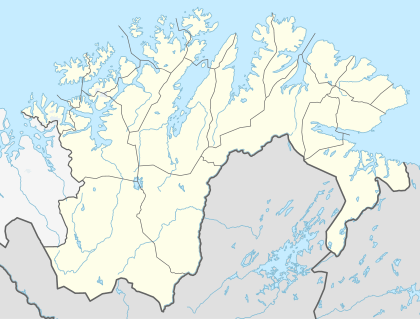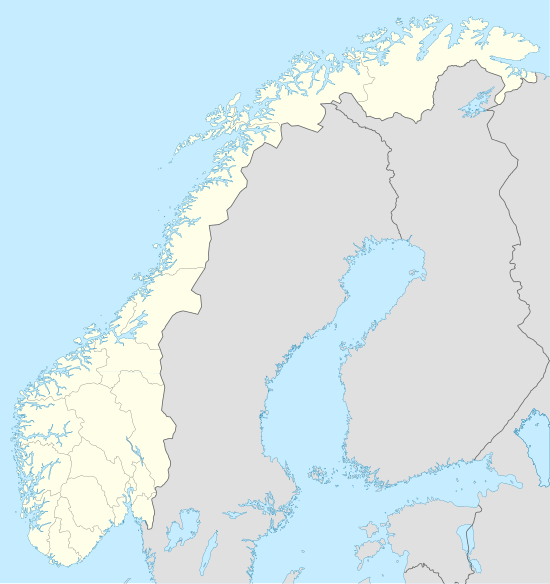Karasjok (village)
| Karasjok Kárášjohka | |
|---|---|
| Village | |
|
View of the historic church in the village | |
 Karasjok  Karasjok Location in Finnmark | |
| Coordinates: 69°28′18″N 25°30′40″E / 69.47167°N 25.51111°ECoordinates: 69°28′18″N 25°30′40″E / 69.47167°N 25.51111°E | |
| Country | Norway |
| Region | Northern Norway |
| County | Finnmark |
| District | Vest-Finnmark |
| Municipality | Karasjok |
| Area[1] | |
| • Total | 2.22 km2 (0.86 sq mi) |
| Elevation[2] | 141 m (463 ft) |
| Population (2013)[1] | |
| • Total | 1,858 |
| • Density | 837/km2 (2,170/sq mi) |
| Time zone | CET (UTC+01:00) |
| • Summer (DST) | CEST (UTC+02:00) |
| Post Code | 9730 Karasjok |
Karasjok (Norwegian) or Kárášjohka (Northern Sami) is the administrative centre of Karasjok Municipality in Finnmark county, Norway. The village is located along both sides of the Karasjohka river, just 12 kilometres (7.5 mi) west of the Norway-Finland border. The European route E06 highway runs through the village on its way from Lakselv to Tana bru and Kirkenes. The 2.22-square-kilometre (550-acre) village has a population (2013) of 1,858, which gives the village a population density of 837 inhabitants per square kilometre (2,170/sq mi).[1]
The village is an important centre in the municipality and region. About 2/3 of the municipal population lives in the village. The Sami Parliament of Norway is located in the village. It acts as an institution of cultural autonomy for the indigenous Sami people in Norway. The Old Karasjok Church and the newer Karasjok Church are located in the village. The newer church is also the seat of the Indre Finnmark deanery of the Church of Norway.[3]
History
Norway was occupied by Germany from 1940 to 1945. In July 1943, 374 political prisoners and POWs from Yugoslavia were shipped to the village, to widen the road to Karigasniemi, Finland.[4] After four or five months, only 111 of these prisoners were still alive.[4] At the end of the prisoners' stay in Karasjok, before transportation out of Karasjok, 45 prisoners were massacred by the firing of small arms.[4]
References
- 1 2 3 Statistisk sentralbyrå (1 January 2013). "Urban settlements. Population and area, by municipality.".
- ↑ "Karasjok" (in Norwegian). yr.no. Retrieved 2013-03-29.
- ↑ Store norske leksikon. "Karasjok" (in Norwegian). Retrieved 2013-03-29.
- 1 2 3 Disse fangene bygget «blodveien» – og så ble de henrettet - De jugoslaviske fangene som var i Karasjok under andre verdenskrig skulle bare bygge veien til Finland, og deretter skulle de ikke eksistere mer. [These prisoners built 'the blood road' - and then they were executed - The Yugoslavian prisoners that were in Karasjok during World War Two, were only to build a road to Finland, and thereafter they were not to exist anymore]
